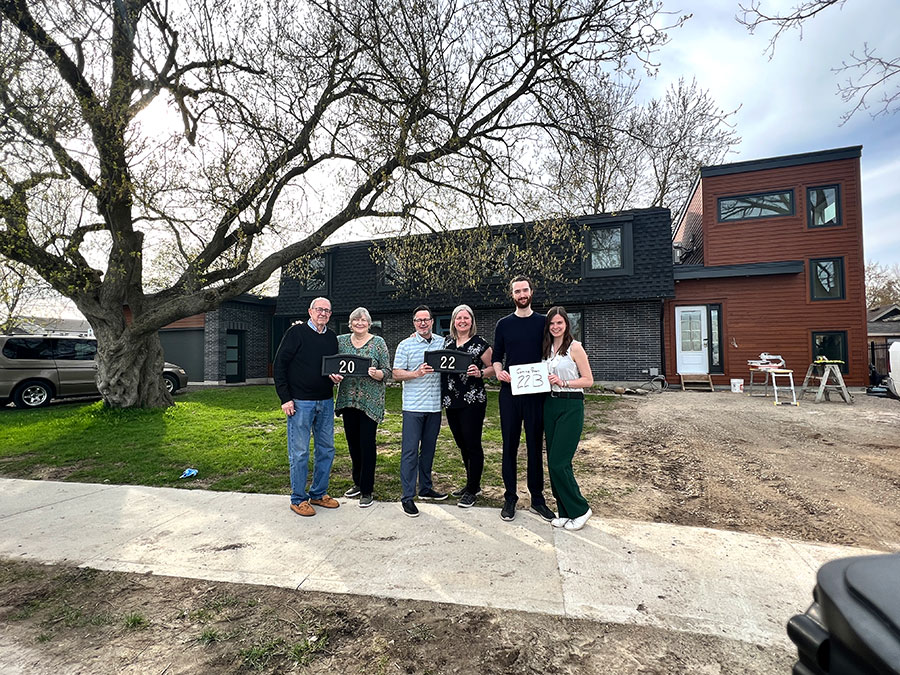Renovations, expansions, and Additional Residential Units (ARUs) at a 1970s-era duplex in Elora have resulted in a three-generation family complex where everyone enjoys their own home with the comfort that loved ones are nearby.
Curt Hammond was the first to arrive on York Street: he purchased one side of the duplex in 2001 as a single parent. A few years later he was dating Melanie Anderson, who subsequently purchased the other side. After they married both houses were renovated: the east half became their home, the west side was Curt’s business on the main floor, with bedrooms upstairs for guests. The duplex was unique in that it had a common exterior front door that allowed easy movement between the two houses without going outside.
“As our kids grew up and attended university or travelled abroad, it was a great space for them to come home to. Through our church, we were also honoured to offer temporary support for individuals and families needing short-term housing,” says Curt. The extra space was especially useful during the pandemic when his children Skyler and Jayna returned from Europe to wait out lockdowns until they could return.
Down the highway in Fergus, Melanie’s parents Vic and Marg Anderson had decided it was time to downsize from the 2,000 square foot home where they had raised their seven children. They sold their home and moved into the west side of the York Street duplex temporarily while they sorted out their next steps. Before long, Curt and Melanie proposed an unexpected option: stay. The upstairs bedrooms would eventually be a barrier, they knew, but by moving the business elsewhere and planning a main floor addition, the space would be ideal long-term for Vic and Marg. An architect helped bring the vision to life: convert the office back to a living space with an addition that included a bedroom, accessible bathroom, utility space, and garage. The upstairs bedrooms would remain available for guests.
“Courageous conversations were important to make sure everyone was comfortable with this,” says Curt. They spoke freely of the pros and cons of the proposal, and after taking time to think it through, Vic and Marg embraced the plan. By financing the renovation as pre-paid rent, they could customize many of the features of their new home in a more affordable arrangement than other housing options. As a bonus, they would be close to family as they aged.
“It was a challenge to build during the pandemic, for sure, all while Vic and Marg were sorting out this major life change. COVID created supply chain issues, delays and cost increases, so constant and honest communication remained important to keep everyone feeling comfortable,” says Curt.
Just as Vic and Marg settled into their expanded home in early 2022, Sky and his partner Juliane elected to return to Wellington County from Europe for the next phase of their life. They realized affordable housing solutions were limited. Curt proposed they add an ARU on the other side of the property. Sky and Juliane could build a home at a reasonable cost because they weren’t purchasing land, and would be close to family as they wanted. They would oversee the financing and construction, drawing on Curt and Melanie for support as needed.
What is an ARU?
An Additional Residential Unit (ARU) is an accessory to a principal dwelling unit, located on the same property.
ARUs can be connected to or detached from the principal home.
Homeowners can choose to add to their existing properties: basement apartments, second or third suites, garage conversions, even smaller homes built on the property.
They add to the rental inventory and often give homeowners a source of income.
While ARUs are permitted in all municipalities in Wellington County, individual allowances vary with regard to size, type, setback and other requirements.
Interested homeowners should start by consulting their local building authorities.
“We knew the municipality was encouraging ARUs as a way to add attainable housing in the community,” said Curt.
Plans for the second extension on the other side of the duplex were drawn up and permit applications submitted. The township required the ARU to be attached to the existing structure, but otherwise, there were no concerns and getting permits was a smooth process. The home would be treated as an independent unit with a separate address. By late 2022, construction was underway and will wrap up this summer. The new home totals just under 1,200 square feet and includes an office, two bedrooms, two bathrooms, and open concept kitchen, dining and living room: perfect for a young couple with the option to work from home. During the renovation, all three homes were updated to 200-amp electrical service and wired to be ready for charging electric vehicles.
Once again, open and frequent communication helped ensure everyone’s opinions and needs were heard. Both couples had lots of open conversations about the outdoor space (the three homes each have a joint deck and share the generously sized back yard), and common exterior aesthetic on the homes and landscaping. While Sky and Juliane designed their dream home interior, Curt had the final say on exterior decisions to ensure all three homes look like they were intentionally designed to work together.
Financial advantages aside, it is being near family, and sense of community, that has been the biggest win with the new multi-generation living arrangement.
“Living in community like this means an extra pair of hands or helpful advice is always a few steps away. It also means we can share resources like small appliances – we don’t need three bread makers, after all, and there is just one BBQ. Best of all, our ‘Blue Door Community’ can host large family gatherings by opening up all our homes for food preparation and to welcome guests. Last Thanksgiving, we used both kitchens, preparing our plates in one home, and walking through the other to a large table set up in the insulated garage next door – it was just perfect.”
To learn more about attainable housing in Wellington County, visit
www.wellington.ca/livehere.





